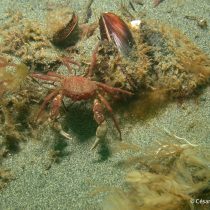
Halicarcinus planatus is a small crustacean, commonly known as southern crab, which is distributed in shallow coastal waters. It is found in the extreme south of South America, including the regions of Aysén and Magallanes, and also the subantarctic islands of the Southern Ocean (Malvinas, Marion, Crozet, Kerguelen and Macquarie). It tends to be more abundant in protected areas such as bays, straits and inlets.
In 2010, an American researcher found on Deception Island, located on the Antarctic Peninsula (south of the South Shetland Archipelago), a female with eggs of this species. The event aroused the curiosity of a team of scientists, because reaching the Antarctic coasts requires dispersion through vast and deep biogeographical barriers that have isolated the continent for millions of years, including the crossing of the Antarctic Circumpolar Current.
This is how the group of researchers carried out a study, the results of which were recently published in the journal Global Change Biology, which states that currently the southern crab cannot establish itself in the waters of the Antarctic Peninsula. However, this situation is very likely to change under the climate change scenario projected in the twenty-first century.
The work was developed thanks to the collaboration of a multidisciplinary team of experts from national and foreign institutions: Centro de Investigación Dinámica de Ecosistemas Marinos de Altas Latitudes de la Universidad Austral Chile (IDEAL-UACh), Universidad de Magallanes (UMAG), Universidad de Chile (UChile), University of Otago (New Zealand), Royal Belgian Institute of Natural Sciences (Belgium), Université Bourgogne Franche-Comté (France) and Université Libre de Bruxelles ( Belgium).
The consequences of global warming
To conduct the study, the researchers used a combination of physiological experiments and ecological models to assess the potential niche of Halicarcinus planatus and estimate its future limits to the south under climatic conditions.
“As a result of the warming that Antarctica has suffered since the mid-twentieth century and the increase in anthropogenic activities, the probability that exotic species will arrive and settle on the white continent is greater. Although, to date there are no established exotic marine species, this situation could change over the years, “says the marine biologist, doctoral student and lead author of the scientific work, Zambra López.
Research shows that the southern crab has a minimum thermal limit of 1 °C, and that its current distribution (assessed by sampling and niche modeling) is physiologically restricted to the sumantarctic region. While this species is currently unable to survive in Antarctica, future warming under highly mitigated and un mitigated greenhouse gas emission scenarios will favor its niche expansion to the West Antarctic Peninsula by the year 2100. Human activity also has the potential to increase the likelihood of anthropogenic translocation of this species to Antarctic ecosystems.
The presence of this crab in Antarctica could be random, however, it is also possible that at some point it could be present in high density.
Successful Antarctic invasions to date have been recorded exclusively in terrestrial habitats. While non-native marine species such as crabs, mussels and tunicates had already been reported on the shores of the white continent, these have not yet established there. Although the full consequences of Antarctic warming have not yet been understood, some changes in the distribution and composition of communities have already been observed.
“Our work shows to this day that this crab cannot withstand Antarctic winters, that is, it is not yet feasible for it to establish and reproduce there. This would change because the effects of climate change continue to increase the temperature, making this crab can establish itself on the white continent throughout the year, “concludes the researcher of the IDEAL Center and co-author of the study, Dr. Luis Vargas-Chacoff.





